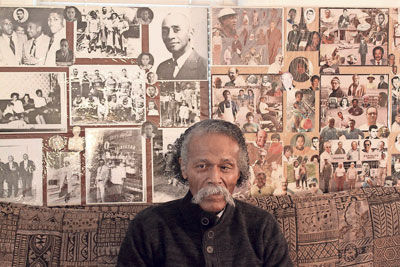By Lea Kahn, Staff Writer
Pleasant Phox moved to Princeton from Virginia in the 1930s, and like virtually all African-Americans who moved here, he settled in the Witherspoon-Jackson neighborhood.
Mr. Phox found work as a laborer with a Princeton construction company. He was among the workmen who excavated the foundation for Princeton University’s Harvey S. Firestone Memorial Library.
Now, seven decades later, his great-grandson, Markus Phox, is a junior at Princeton University and studying in the library that his great-grandfather helped to build.
The Phox family is one of many success stories that could be told of the families that lived in the historically African-American Witherspoon-Jackson neighborhood, said Birch Avenue resident Romus Broadway.
And it is likely that members of the Phox family will be included in one of the 10 or 12 photo collages that Mr. Broadway is putting on display in the hallway at the Witherspoon Hall municipal building Monday night.
The collage is being placed in advance of a special Princeton Council meeting, set for 7 p.m. in the main meeting room, to review the proposed historic designation of the Witherspoon-Jackson neighborhood. The proposed district is bounded by Witherspoon Street, John Street, Paul Robeson Place and Birch Avenue.
Mr. Broadway’s photo collage includes pictures of many residents of the Witherspoon-Jackson neighborhood — mostly African-Americans, but also many of the Italian-Americans and Irish-Americans who lived there side by side with them.
“I took pictures of the people. I knew them. I am a social historian. I think in those terms,” he said.
Mr. Broadway said he hopes the photo collage will introduce viewers to the proposed Witherspoon-Jackson Historic District and show off the people who lived there, what they did and what they achieved — “what came out of those houses.”
The 77-year-old Mr. Broadway, whose family has lived on Birch Avenue since 1942, has been documenting the Witherspoon-Jackson neighborhood since he got his first camera in 1955.
“The reason I started doing it is because the only pictures that many children had was the school picture. I wanted to catch them in their setting, with their friends, so they could see themselves,” said Mr. Broadway, whose photographs serve as a social history of the neighborhood.
Mr. Broadway took photographs of the Witherspoon-Jackson neighborhood residents wherever he could find them — at weddings, in social halls and on the street. Sometimes, it was just candid photographs of the people going about their business.
Mr. Broadway recalled the Italian-American families — the Pinelli, Leiggi, Cifelli, Boccanfuso, Perone, DiMeglio and Balestrieri families among them — that lived in the neighborhood, as well as the African-American families. They owned gasoline stations and bars, and some of their offspring became Princeton police officers.
Mr. Broadway especially remembers the funerals of Anthony Pinelli and Joseph Pinelli, who served in the U.S. Army and died during World War II. Everyone in the neighborhood followed the caissons to the cemetery at St. Paul’s Roman Catholic Church on Nassau Street — African-Americans as well as Italian-Americans, he said.
The Pinellis were among three Birch Avenue residents who were killed in battle during World War II, Mr. Broadway said. Johnny Lewis, an African-American, was the third casualty. They were among the nearly 60 Birch Avenue residents who served in the military during World War II, the Korean War and the Vietnam War.
Many of the African-Americans whose photographs appear on the collage worked as laborers, chauffeurs, butlers, cooks and maids in households on Westcott Road and Cleveland Lane. They were hotel workers and waiters, plumbers and a couple of school teachers.
“They did the dirty work and took the jobs that no one else wanted to do, and they dignified it. They were underpaid, overworked and under-appreciated,” Mr. Broadway said.
But in the decades that followed, many of the children, grandchildren and great-grandchildren have gone on to attend college — including Ivy League universities — and pursued careers that have taken them out of the neighborhood and out of the town.
Just on Birch Avenue alone, the families that lived there produced five attorneys, an architect, a vice principal at Princeton High School, and two residents who earned Ph.D. degrees, he said.
Mr. Broadway said proudly that his granddaughter and two of his nephews are graduates of The Lawrenceville School — the first place where his own father, John R. Broadway Sr., worked when he moved north from Virginia in 1925. He was a dish-washer at the prestigious preparatory school in Lawrence Township.
Asked whether he thinks the neighborhood deserves historic status, Mr. Broadway replied that “absolutely” it should be designated as historic. It is one way to preserve what is left of the houses and the history of the Witherspoon-Jackson neighborhood.
“We were like caretakers, and now people are coming into the neighborhood and (building) mega-mansions. The stories these houses could tell will be gone. All of that history is going to end up in a landfill,” Mr. Broadway said.

